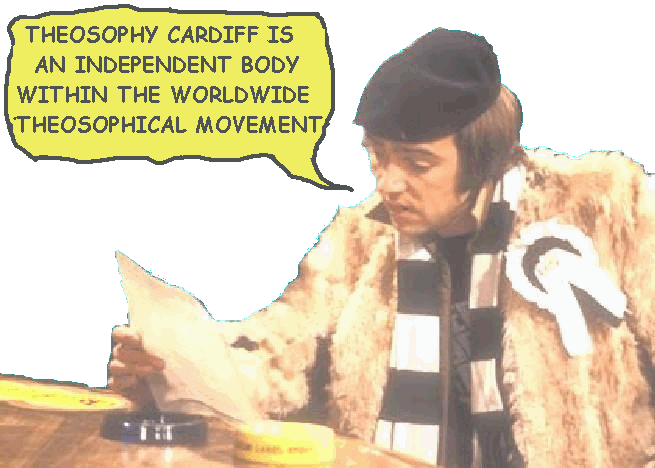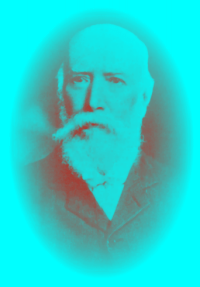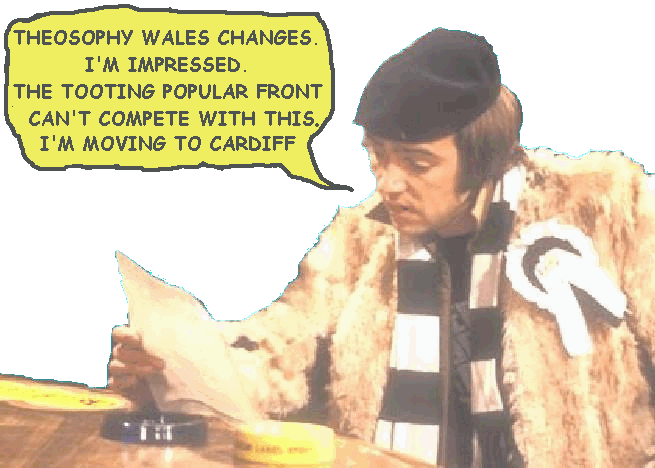VANGUARD
Phase
1 Standard Vanguard introduced July 1947
The Standard Vanguard was produced
by the Standard Motor Company
in
The Standard Vanguard has very little (in fact
nothing)
to do with Theosophy but we have found that
Theosophists and new enquirers do like pictures
of classic cars and we get a lot of positive
feedback.
You can find Theosophy Wales groups
in
Bangor, Cardiff, Conwy & Swansea
Theosophy Wales has no controlling
body
and is made up of independent groups
________________________
Theosophy
we
are pleased to present here an in depth manual of Theosophical ideas and
concepts by Alfred Percy Sinnett
who
was a major contributor to the development of modern Theosophy in the early
years of the Theosophical movement
Esoteric
Buddhism
By
Alfred
Percy Sinnett
The Universe
Chapter 11
IN all Oriental literature
bearing on the constitution of the cosmos, frequent reference is made to the
days and the nights of Brahmâ; the in-breathings and the out-breathings of the
creative principle, the periods of manvantara, [As transliterated into English,
this word may be written either manwantara or manvantara; and the
proper pronunciation is something between the two, with the accent on the
second syllable.] and the periods of pralaya. This idea runs into various Eastern
mythologies, but in its symbolical aspects we need not follow it here. The
process in Nature to which it refers is of course the alternate succession of
activity and repose that is observable at every step of the great ascent from
the infinitely small to the infinitely great. Man has a manvantara and pralaya
every four-and-twenty hours, his periods of waking and sleeping; vegetation
follows the same rule from year to year as it subsides and revives with the
seasons. The world, too, has its manvantaras and pralayas, when the tide-wave
of humanity approaches its shore, runs through the evolution of its seven
races, and ebbs away again, and such a manvantara has been treated by most
exoteric religions as the whole cycle of eternity.
The major manvantara of our planetary chain is that which comes to an end when
the last Dhyân Chohan of the seventh round of perfected humanity passes into
Nirvana. And the expression has thus to be regarded as one of considerable
elasticity. It may be said indeed to have infinite elasticity, and that is one
explanation of the confusion which has reigned in all treatises on Eastern
religions in their popular aspects. All the root-words transferred to popular
literature from the secret doctrine have a seven-fold significance at least,
for the initiate, while the uninitiated reader, naturally supposing that one
word means one thing, and trying always to clear up its meaning by collating
its various applications, and striking an average, gets into the most hopeless
embarrassment.
The planetary chain with which we are concerned is not the only one which has
our sun as its centre. As there are other planets besides the earth in our
chain, so there are other chains besides this in our solar system. There are
seven such, and there comes a time when all these go into pralaya together.
This is spoken of as solar pralaya, and within the interval between two such
pralayas, the vast solar manvantara covers seven pralayas and manvantaras of
our - and each other - planetary chain. Thought is baffled, say even the
adepts, in speculating as to how many of our solar pralayas must come before
the great cosmic night in which the whole universe, in its collective enormity,
obeys what is manifestly the universal law of activity and repose, and with all
its myriad systems passes itself into pralaya. But even that tremendous result,
says esoteric science, must surely come.
After the pralaya of a single planetary chain there is no necessity for a
recommencement of evolutionary activity absolutely de novo. There is
only a resumption of arrested activity. The vegetable and animal kingdoms,
which at the end of the last corresponding manvantara had reached only a
partial development, are not destroyed. Their life or vital energy passes
through a night, or period of rest; they also have, so to speak, a Nirvana of
their own, as why should they not, these fśtal and infant entities? They are
all, like ourselves, begotten of the one element. As we have our Dhyân Chohans,
so have they in their several kingdoms elemental guardians, and are as well
taken care of in the mass as humanity is in the mass. The one element not only
fills and is space, but interpenetrates every atom of cosmic matter.
When, however, the hour of the solar pralaya strikes, though the process of
man’s advance on his last seventh round is precisely the same as usual, each
planet, instead of merely passing out of the visible into the invisible, as he
quits it in turn, is annihilated. With the beginning of the seventh round of
the seventh planetary chain manvantara, every kingdom having now reached its
last cycle, there remains on each planet, after the exit of man, merely the mâyâ
of once living and existing forms. With every step he takes on the descending
and ascending arcs, as he moves on from globe to globe, the planet left behind
becomes an empty chrysaloidal case. At his departure there is an outflow from
every kingdom of its entities. Waiting to pass into higher forms in due time,
they are nevertheless liberated, and to the day of the next evolution they will
rest in their lethargic sleep in space, until brought into life again at the
new solar manvantara. The old elementals will rest till they are called on to
become in their turn the bodies of mineral, vegetable, and animal entities on
another and a higher chain of globes on their way to become human entities,
while the germinal entities of the lowest forms - and at that time there will
remain but few of such - will hang in space like drops of water suddenly turned
into icicles. They will thaw at the first hot breath of the new solar
manvantara, and form the soul of the future globes. The slow development of the
vegetable kingdom, up to the period we are now dealing with, will have been
provided for by the longer interplanetary rest of man. When the solar pralaya
comes, the whole purified humanity merges into Nirvana, and from that
intersolar Nirvana will be reborn in the higher systems. The strings of worlds
are destroyed, and vanish like a shadow from the wall when the light is
extinguished. “We have every indication,” say the adepts, “that at this very
moment such a solar pralaya is taking place, while there are two minor ones
ending somewhere.”
At the beginning of the new solar manvantara the hitherto subjective elements
of the material worlds, now scattered in cosmic dust, receiving their impulse
from the new Dhyân Chohans of the new solar system (the highest of the old ones
having gone higher), will form into primordial ripples of life, and, separating
into differentiating centres of activity, combine in a graduated scale of seven
stages of evolution. Like every other orb of space, our earth has, before
obtaining its ultimate materiality, to pass through a gamut of seven stages of
density. Nothing in this world now can give us an idea of what that ultimate
stage of materiality is like. The French astronomer Flammarion, in a book
called La Résurrection et la Fin des Mondes, has approached a conception
of this ultimate materiality. The facts are, I am informed, with slight
modifications, much as he surmises. In consequence of what he treats as secular
refrigeration, but which more truly is old age and loss of vital power, the
solidification and desication of the earth at last reaches a point when the
whole globe becomes a relaxed conglomerate. Its period of child-bearing has
gone by; its progeny are all nurtured; its term of life is finished. Hence its
constituent masses cease to obey those laws of cohesion and aggregation which
held them together. And becoming like a corpse, which, abandoned to the work of
destruction, leaves each molecule composing it free to separate itself from the
body, and obey in future the sway of new influences, “the attraction of the
moon,” suggests M. Flammarion, “would itself undertake the task of demolition
by producing a tidal wave of earth particles instead of an aqueous tide.” This
last idea must not be regarded as countenanced by occult science except so far
as it may serve to illustrate the loss of molecular cohesion in the material of
the earth.
Occult physics pass fairly into the region of metaphysics, if we seek to obtain
some indication of the way in which evolution recommences after a universal
pralaya.
The one eternal, imperishable thing in the universe, which universal pralayas
themselves pass over without destroying, is that which may be regarded
indifferently as space, duration, matter or motion; not as something having
these four attributes, but as something which is these four things at
once and always. And evolution takes its rise in the atomic polarity which
motion engenders. In cosmogony the positive and the negative, or the active and
the passive, forces correspond to the male and female principles. The spiritual
efflux enters into the veil of cosmic matter; the active is attracted by the
passive principle, and if we may here assist imagination by having recourse to
old occult symbology - the great Nag - the serpent emblem of eternity, attracts
its tail to its mouth, forming thereby the circle of eternity, or rather cycles
in eternity. The one and chief attribute of the universal spiritual principle,
the unconscious but ever active life-giver, is to expand and shed; that of the
universal material principle is to gather in and fecundate. Unconscious and
non-existing when separate, they become consciousness and life when brought
together. The word Brahmâ comes from the Sanscrit root brih, to expand,
grow, or fructify, esoteric cosmogony being but the vivifying expansive force
of Nature in its eternal evolution. No one expression can have contributed more
to mislead the human mind in basic speculation concerning the origin of things
than the word “creation.” Talk of creation, and we are continually butting
against the facts. But once realize that our planet and ourselves are no more
creations than an iceberg, but states of being for a given time - that their
present appearance, geological or anthropological, is transitory and but a
condition concomitant of that stage of evolution at which they have arrived -
and the way has been prepared for correct thinking. Then we are enabled to see
what is meant by the one and only principle or element in the universe, and by
the treatment of that element as androgynous; also by the proclamation of Hindu
philosophy that all things are but Mâyâ - transitory states - except the
one element which rests during the maha-pralayas only - the nights of Brahmâ.
Perhaps we have now plunged deeply enough into the fathomless mystery of the
great First Cause. It is no paradox to say that, simply by reason of ignorance,
do ordinary theologians think they know so much about God. And it is no
exaggeration to say that the wondrously endowed representatives of occult
science, whose mortal nature has been so far elevated and purified that their
perceptions range over other worlds and other states of existence, and commune
directly with beings as much greater than ordinary mankind, as man is greater
than the insects of the field, it is the mere truth that they never occupy
themselves at all with any conception remotely resembling the God of churches
and creeds. Within the limits of the solar system, the mortal adept knows, of
his own knowledge, that all things are accounted for by the law, working on
matter in its diverse forms, plus the guiding and modifying influence of
the highest intelligences associated with the solar system, the Dhyân Chohans,
the perfected humanity of the last preceding manvantara. These Dhyân Chohans,
or Planetary Spirits, on whose nature it is almost fruitless to ponder, until
one can at least realize the nature of disembodied existence in one’s own case,
impart to the reawakening worlds at the end of a planetary chain pralaya such
impulses that evolution feels them throughout its whole progress. The limits of
Nature’s great law restrain their action. They cannot say, let there be
paradise throughout space, let all men be born supremely wise and good; they
can only work through the principle of evolution, and they cannot deny to any
man who is to be invested with the potentiality of development himself into a
Dhyân Chohan, the right to do evil, if he prefers that to good. Nor can they
prevent evil, if done, from producing suffering. Objective life is the soil in
which the life-germs are planted; spiritual existence (the expression being
used, remember, in contrast merely to grossly material existence) is the flower
to be ultimately obtained. But the human germ is something more than a flower
seed; it has liberty of choice in regard to growing up or growing down, and it
could not be developed without such liberty being exercised by the plant. This
is the necessity of evil. But within the limits that logical necessity
prescribes, the Dhyân Chohan impresses his conceptions upon the evolutionary
tide, and comprehends the origin of all that he beholds.
Surely as we ponder in this way over the magnitude of the cyclic evolution with
which esoteric science is in this way engaged, it seems reasonable to postpone
considerations as to the origin of the whole cosmos. The ordinary man in this
earth-life, with many, certainly some hundred, earth-lives to come, and their
very much more important inter-incarnation periods (more important, that is, as
regards duration and the prospect of happiness or sorrow) also in prospect, may
surely be most wisely occupied with the inquiries whose issue will affect
practical results, than with speculation in which he is practically quite
uninterested. Of course, from the point of view of religious speculation
resting on no positive knowledge of anything beyond this life, nothing can be
more important or more highly practical than conjectures as to the attributes
and probable intentions of the terrible, personal Jehovah, pictured as an
omnipotent tribunal, into whose presence the soul at its death is to be
introduced for judgement. But scientific knowledge of spiritual things throws
back the day of judgement into a very dim perspective, the intervening period
being filled with activity of all kinds. Moreover, it shows mankind that
certainly, for millions and millions of centuries to come, it will not be confronted
with any judge at all, other than that all-pervading judge, that Seventh
Principle, or Universal Spirit, which exists everywhere, and, operating on
matter, provokes the existence of man himself, and the world in which he lives,
and the future conditions towards which he is pressing. The Seventh Principle,
undefinable, incomprehensible for us at our present stage of enlightenment, is
of course the only God recognized by esoteric knowledge, and no personification
of this can be otherwise than symbolical.
And yet, in truth, esoteric knowledge, giving life and reality to ancient
symbolism in one direction, as often as it conflicts with modern dogma in the
other, shows how far from absolutely fabulous are even the most anthropomorphic
notions of Deity associated by exoteric tradition with the beginning of the
world. The Planetary Spirit, actually incarnated among men in the first round,
was the prototype of personal deity in all subsequent developments of the idea.
The mistake made by uninstructed men in dealing with the idea is merely one of
degree. The personal God of an insignificant minor manvantara has been taken
for the creator of the whole cosmos, a most natural mistake for people forced,
by knowing no more of human destiny than was included in one objective
incarnation, to suppose that all beyond was a homogeneous spiritual future. The
God of this life, of course, for them, was the God of all lives and worlds and
periods.
The reader will not misunderstand me, I trust, to mean that esoteric science regards
the Planetary Spirit of the first round as a god. As I say, it is concerned
with the working of Nature in an immeasurable space, from an immeasurable past,
and all through immeasurable future. The enormous areas of time and space in
which our solar system operates is explorable by the mortal adepts of
esoteric science. Within those limits they know all that takes place, and how
it takes place, and they know that everything is accounted for by the
constructive will of the collective host of the Planetary Spirits, operating
under the law of evolution that pervades all Nature. They commune with these
Planetary Spirits, and learn from them that the law of this, is the law of
other solar systems as well, into the regions of which the perceptive faculties
of the Planetary Spirits can plunge as the perceptive faculties of the adepts
themselves can plunge into the life of other planets of this chain. The law of
alternating activity and repose is operating universally; for the whole cosmos,
even though at unthinkable intervals, pralaya must succeed manvantara, and
manvantara, pralaya.
Will any one ask to what end does this eternal succession work? Is it better to
confine the question to a single system, and as to what end does the original
nebula arrange itself in planetary vortices of evolution, and develop worlds in
which the universal spirit, reverberating through matter, produces form and
life and those higher states of matter in which that which we call subjective
or spiritual existence is provided for. Surely it is end enough to satisfy any
reasonable mind that such sublimely perfected beings as the Planetary Spirits
themselves come thus into existence, and live a conscious life of supreme
knowledge and felicity, through vistas of time which are equivalent to all we
can imagine of eternity. Into this unutterable greatness every living thing has
the opportunity of passing ultimately. The Spirit which is in every animated
form, and which has even worked up into these, from forms we are generally in
the habit of calling inanimate, will slowly but certainly progress onwards
until the working of its untiring influence in matter has evolved a human soul.
It does not follow that the plants and animals around us have any principle
evolved in them as yet which will assume a human form in the course of the
present manvantara; but though the course of an incomplete evolution may be
suspended by a period of natural repose, it is not rendered abortive.
Eventually every spiritual monad - itself a sinless unconscious principle, will
work through conscious forms on lower levels, until these, throwing off one
after another higher and higher forms, will produce that in which the God-like
consciousness may be fully evoked. Certainly it is not by reason of the
grandeur of any human conceptions as to what would be an adequate reason for
the existence of the universe, that such a consummation can appear an
insufficient purpose, not even if the final destiny of the planetary spirit
himself, after periods to which his development from the mineral forms of
primćval worlds is but a childhood in the recollection of the man, is to merge
his glorified individuality into that sum total of all consciousness, which
esoteric metaphysics treat as absolute consciousness, which is non-consciousness.
These paradoxical expressions are simply counters representing ideas that the
human mind is not qualified to apprehend, and it is waste of time to haggle
over them.
These considerations supply the key to esoteric Buddhism, a more direct outcome
of the universal esoteric doctrine than any other popular religion, for the
effort in its construction has been to make men love virtue for its own sake
and for its good effect on their future incarnations, not to keep them in
subjection to any priestly system or dogma by terrifying their fancy with the
doctrine of a personal judge waiting to try them for more than their lives at
their death. Mr Lillie is mistaken, admirable as his intention has been, and
sympathetic as his mind evidently is with the beautiful morality and aspiration
of Buddhism, in deducing from its Temple ritual the notion of a Personal God.
No such conception enters into the great esoteric doctrine of Nature, of which
this volume has furnished an imperfect sketch. Not even in reference to the farthest
regions of the immensity beyond our own planetary system, does the adept
exponent of the esoteric doctrine tolerate the adoption of an agnostic
attitude. It will not suffice for him to say, “As far as the elevated senses of
planetary spirits, whose cognition extends to the outermost limits of the
starry heavens - as far as their vision can extend, Nature is self-sufficing;
as to what may lie beyond, we offer no hypothesis.” What the adept really says
on this head is, “The universe is boundless, and it is a stultification of
thought to talk of any hypothesis setting in beyond the boundless - on the
other side of the limits of the limitless.”
That which antedates every manifestation of the universe, and would lie beyond
the limit of manifestation, if such limits could ever be found, is that which
underlies the manifested universe within our own purview - matter animated by
motion, its Parabrahm or Spirit. Matter, space, motion, and duration,
constitute one and the same eternal substance of the universe. There is nothing
else eternal absolutely. That is the first state of matter, itself perfectly
uncognizable by physical senses, which deal with manifested matter, another
state altogether. But though thus in one sense of the word materialistic, the
esoteric doctrine, as any reader of the foregoing explanations will have seen,
is as far from resembling the gross narrow-minded conception of Nature, which
ordinary goes by the name of Materialism, as the North Pole looks away from the
South. It stoops to Materialism, as it were, to link its methods with the logic
of that system, and ascends to the highest realms of idealism, to embrace and
expound the most exalted aspirations of Spirit. As it cannot be too frequently
or earnestly repeated - it is the union of Science and Religion - the bridge by
which the most acute and cautious pursuers of experimental knowledge may cross
over to the most enthusiastic devotee, by means of which the most enthusiastic
devotee may return to Earth and yet keep Heaven still around him.

Standard
Vanguard Brochure Cover Late 1940s
In
1949 you could buy a Vanguard for Ł671 (including purchase tax)
_____________________________
More Theosophy Stuff
with these links
Cardiff Theosophical
Society meetings are informal
and there’s always a
cup of tea afterwards
The
Cardiff Theosophical Society Website

1948
Standard Vanguard
The
National Wales Theosophy Website
Bangor,
Cardiff, Conwy & Swansea
If you
run a Theosophy Group, please feel free
to use
any of the material on this site

1953
Standard Vanguard Pickup
The Most Basic Theosophy
Website in the Universe
A quick overview of Theosophy
and the Theosophical Society
If you run a Theosophy Group you
can use this as an introductory handout.
Theosophy Cardiff’s Instant Guide

Phase
II Standard Vanguard 1953 -55
Theosophical Movement in Wales
as it separates into independent
groups that run do their own show
One liners and quick explanations
H P
Blavatsky is usually the only
Theosophist
that most people have ever
heard
of. Let’s put that right
The Voice of the Silence Website

Phase
III Standard Vanguard Circa 1959
An
Independent Theosophical Republic
Links
to Free Online Theosophy
Study
Resources; Courses, Writings,
The main criteria for the inclusion of
links on this site is that they have some
relationship (however tenuous) to Theosophy
and are lightweight, amusing or entertaining.
Topics include Quantum Theory and Socks,
Dick Dastardly and Legendary Blues Singers.
A selection of articles on Reincarnation
Provided in response to the large
number of enquiries we receive at
Cardiff Theosophical Society on this subject

Phase
III Standard Vanguard Circa 1962
The Voice of the Silence Website
This is for
everyone, you don’t have to live
in Wales to
make good use of this Website

A
Phase I 1949 Standard Vanguard with sidelights
A Vanguard tested by The Motor magazine in 1949
had a top speed of 78.7 mph
(126.7 km/h) and could accelerate from 0-60 mph
(97 km/h) in 21.5 seconds.
A fuel consumption of 22.9 miles per imperial
gallon
No
Aardvarks were harmed in the

Phase
III Standard Vanguard Early 60s
Within the British Isles, The Adyar Theosophical Society
has Groups in;
Bangor*Basingstoke*Billericay*Birmingham*Blackburn*Bolton*Bournemouth
Bradford*Bristol*Camberley*Cardiff*Chester*Conwy*Coventry*Dundee*Edinburgh
Folkstone*Glasgow*Grimsby*Inverness*Isle of
Man*Lancaster*Leeds*Leicester
Letchworth*London*Manchester*Merseyside*Middlesborough*Newcastle upon
Tyne
North Devon*Northampton*Northern Ireland*Norwich*Nottingham
Perth*Republic of Ireland*Sidmouth*Southport*Sussex*Swansea*Torbay
Tunbridge Wells*Wallasey*Warrington*Wembley*Winchester*Worthing
The Spiritual Home of Urban Theosophy
The Earth Base for Evolutionary Theosophy
_____________________
Concerns about the fate of the
wildlife as
Tekels Park is to be Sold to a
Developer
Concerns are raised about the fate of
the wildlife as
The Spiritual Retreat, Tekels Park in
Camberley,
Surrey, England is to be sold to a
developer.
Tekels Park is a 50 acre woodland
park, purchased
for the Adyar Theosophical Society in England
in 1929.
In addition to concern about the park,
many are
worried about the future of the Tekels Park
Deer
as they are not a protected species.
Anyone planning a “Spiritual” stay at
the
Tekels Park Guest House should be
aware of the sale.
It doesn’t require a Diploma in Finance
and even someone with a Diploma in
Astral Travel will know that this is a
bad time economically to sell Tekels Park
____________________
A
B
C
D
EFG
H
IJ
KL
M
N
OP
QR
S
T
UV
WXYZ
Complete Theosophical Glossary in Plain Text Format
1.22MB
Quick
Explanations with Links to More Detailed Info
What is Theosophy ? Theosophy Defined (More Detail)
Three Fundamental Propositions Key Concepts of Theosophy
Cosmogenesis
Anthropogenesis
Root Races
Karma
Ascended Masters After Death States Reincarnation
The Seven Principles of Man Helena Petrovna Blavatsky
Colonel Henry Steel Olcott William Quan Judge
The Start of the Theosophical Society
History of the Theosophical Society
Theosophical Society Presidents
History of the Theosophical Society in Wales
The Three Objectives of the Theosophical Society
Explanation of the Theosophical Society Emblem
Glossaries of Theosophical Terms
An Outstanding Introduction to Theosophy
By a student of Katherine Tingley
Elementary Theosophy Who is the Man? Body and Soul
Body, Soul and Spirit Reincarnation Karma

Standard
Vanguard Promotional Literature Late 1940s
What Theosophy Is From the Absolute to Man
The Formation of a Solar System The Evolution of Life
The Constitution of Man After Death Reincarnation
The Purpose of Life The Planetary Chains
The Result of Theosophical Study
An Outline of Theosophy
Charles Webster Leadbeater
Theosophy - What it is How is it Known? The Method of Observation
General Principles The Three Great Truths The Deity
Advantage Gained from this
Knowledge The Divine Scheme
The Constitution of Man The True Man Reincarnation
The Wider Outlook Death Man’s Past and Future
Cause and Effect What Theosophy does for us

Standard Vanguard Estate
Circa 1952
Try these if you are looking
for a local
Theosophy Group or Centre
UK Listing of Theosophical Groups
Please tell us about your UK Theosophy Group
___________________
into categories and
presented according to relevance of website.
Web Directory
- Add Link - Submit Article - Online Store - Forum

Standard
Vanguard Van Circa 1952
______________________

General pages about Wales, Welsh History
and The History of Theosophy in Wales
Wales is a
Principality within the United Kingdom and has an eastern
border with
England. The land area is just over 8,000 square miles.
Snowdon in North
Wales is the highest mountain at 3,650 feet.
The coastline is almost
750 miles long. The population of Wales
as at the 2001 census is 2,946,200.
________________

Bangor Conwy & Swansea Lodges are
members
of the Welsh Regional Association
(Formed 1993).
Theosophy Cardiff separated from the
Welsh Regional
Association in March 2008 and became an independent
body within the Theosophical Movement in March 2010
High
Drama & Worldwide Confusion
as
Theosophy Cardiff Separates from the
Welsh
Regional Association (formed 1993)
Theosophy Cardiff cancels its Affiliation
to the Adyar Based Theosophical Society
Cardiff, Wales,
UK, CF24 – 1DL




